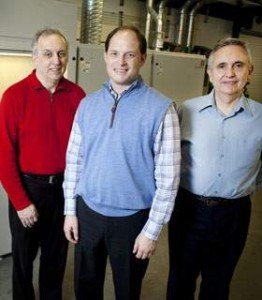
2014 Innovation Awards: General Nano LLC Named Finalist
A University of Cincinnati College of Engineering and Applied Science (CEAS) spin-off company,
, has been named a finalist of the
2014 Business Courier Innovation Awards
. The young company, which manufactures nanoscale materials for aerospace and defense applications, licenses inventions from UC. General Nano previously won the
at the 2013 Business Courier Innovation Awards.
Mark Schulz
, CEAS
Department of Mechanical and Materials Engineering
professor,
Vesselin Shanov
, CEAS
Department of Biomedical, Chemical, and Environmental Engineering
associate professor, and
Joe Sprengard
, president and CEO of General Nano, founded the company in 2009. Based in Norwood, the firm specializes in developing carbon nanotube materials for aerospace and defense applications. Their customers include the
,
, and numerous aerospace and defense original equipment manufacturers and Prime Contractors.
Carbon nanotubes are carbon atoms arranged in hexagonal patterns forming a tube. They are one hundred thousandth of the width of a human hair, possess twice the strength of any other engineering material on Earth, serve as excellent thermal and electrical conductors, and they have the potential to replace the use of copper and aluminum. In 2007, a UC research team led by Shanov was credited with creating the longest carbon nanotube forests ever, measuring 18 millimeters.
General Nanos exotic materials have been attracting the attention of numerous investors, including the United States military. Recently, the Office of Naval Research awarded the company $1.3 million to conduct work on structural composites and energy storage devices over a span of two years.
The only nanotube materials that are currently commercially available are usually short in length and come in powder form to be used in coating and fillers. General Nano synthesizes the materials using a special catalyst particletheir secret sauce, if you willthat lasts significantly longer during the high temperature and pressure production process. This particle promotes the nanotubes to grow longer.
According to Sprengard, General Nanos sheet and tape products could replace copper and aluminum in some military systems. One reason is that in aerospace, everything is about weight and nanotubes weigh much less than either copper or aluminum.
Among the various applications of these carbon nanotube materials is the ability to expend heat from electronics boxes in satellites or missiles and also, to apply the materials light-absorption properties to coatings for space instruments.

2014 NMD Workshop Participants
In addition to the military and aerospace applications, Sprengard said the technology has sparked interest in other fields where the ability to remove weight without sacrificing other properties is attractive.
Were already seeing interest in the automotive and energy sectors, he said, citing wind energy in particular. A lot of the work were doing is transferable to wind technology. They need turbine blades that are longer, stronger and more conductive so they dont ice up.
To date, General Nano has accumulated $5.8 million from Ohio, the Department of Defense and private investors. The
technology funding initiative donated $2 million of that total to make advanced materials a focus for the firm.
General Nano recently sponsored and presented at the UC-hosted
2014 Nanotechnology Materials and Devices (NMD) Workshop
. The sixth NMD workshop was sponsored by the
; the
; the
UC College of Engineering and Applied Science
; the
University of Dayton Research Institute (UDRI)
; and the
Air Force Research Laboratory (AFRL)
along with industrial partners
;
International Space Elevator Consortium (ISEC)
;
;
;
;
; and
.
About 130 participants from seven countriesAustralia, Canada, China, Italy, Japan, U.K. and the U.S.were in attendance to represent numerous government institutions, universities and industries. The workshop benchmarked the current state of the art and developed plans for future breakthroughs in engineering materials and devices based on nanotechnology.
The Innovation Awards celebrate innovative people and companies that show how new ideas can be developed into fuel for the Tri-States economic engine. The program is presented by the
and community partner
. Sponsors of the award include:
UC College of Engineering and Applied Science
;
; and
.
Winners will be announced at an event on April 10, 2014 and will be featured in the April 11th Business Courier.
For more information about General Nano LLC, please visit:
http://www.generalnanollc.com/
For more information about the UC Nanoworld Laboratory, please visit:
http://www.min.uc.edu/nanoworldsmart/
For more information about the UC College of Engineering and Applied Science, please visit:
Additional Contacts
Related Stories
UC’s Ground Floor Makerspace births combat robots
April 17, 2024
In the heart of UC's 1819 Innovation Hub lies the Ground Floor Makerspace, an advanced and active hub of ingenuity where students, faculty and the community converge to bring their ideas to life. This includes being the birthplace of robots much like miniature race cars, combating fender to fender in an enclosed boxing ring. Combat robots like UC's Maximizer will again be fighting for first place in the National Havoc Robot League (NHRL) competition, slated for April 20.
UC researchers develop new CPAP device
April 17, 2024
Researchers at the University of Cincinnati are developing a VortexPAP machine that takes advantage of vortex airflow technology. A preliminary clinical study with current CPAP users demonstrated that the VortexPAP can deliver the pressure levels that are used in the subjects’ CPAP therapy, but the mask is more comfortable to wear. It has a minimalistic design that is less intrusive and barely touches the patient’s face.
UC architectural engineering alumna inspires high school students
April 16, 2024
University of Cincinnati alumna Emma Wilhelmus fell in love with engineering when she was in ninth grade. After taking drafting, architecture and engineering courses in high school, she set out to major in architectural engineering in college. Now, she is an engineering teacher at a local high school and hopes to inspire students.
